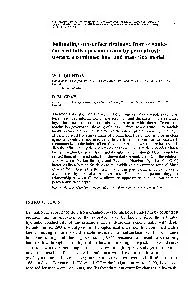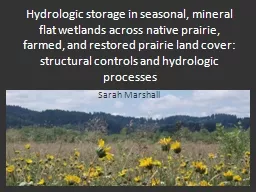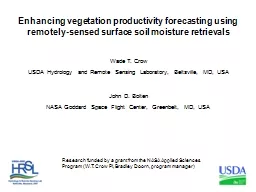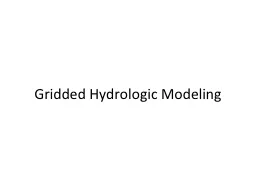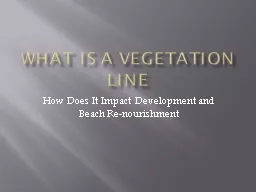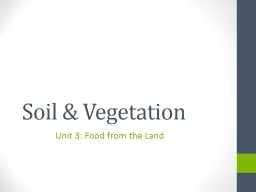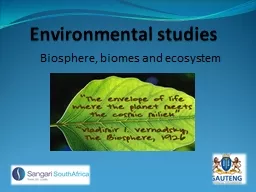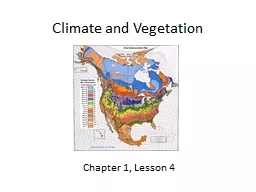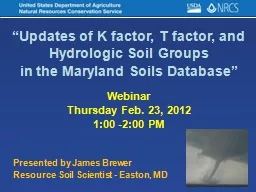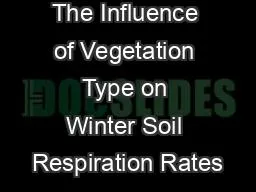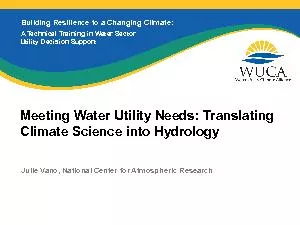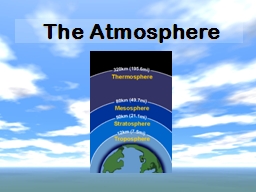PDF-Soil-Vegetation-Atmosphere Transfer Schemes and Large-Scale Hydrologic
Author : giovanna-bartolotta | Published Date : 2015-11-24
Estimatin a W Department of Geography Simon Fraser 33 W L Quinton D M Gray conductivit a a Quinto et al a STUD Mos a m m m METHODOLOG Trace a wher L t T T
Presentation Embed Code
Download Presentation
Download Presentation The PPT/PDF document "Soil-Vegetation-Atmosphere Transfer Sche..." is the property of its rightful owner. Permission is granted to download and print the materials on this website for personal, non-commercial use only, and to display it on your personal computer provided you do not modify the materials and that you retain all copyright notices contained in the materials. By downloading content from our website, you accept the terms of this agreement.
Soil-Vegetation-Atmosphere Transfer Schemes and Large-Scale Hydrologic: Transcript
Estimatin a W Department of Geography Simon Fraser 33 W L Quinton D M Gray conductivit a a Quinto et al a STUD Mos a m m m METHODOLOG Trace a wher L t T T T f wher g S D Soi v. Design. Reading: Applied Hydrology Sections 13-1, . 13-2. 2. Hydrologic design . Water control. Peak flows, erosion, pollution, etc. . Water management. Domestic and industrial use, irrigation, instream flows, etc. Sarah . Marshall. Overview. Context. Research Questions. Approach (3 parts). Status. Obstacles. Preliminary Findings. Anticipated Outcomes. Context. Willamette Valley Lowlands Study Area. Native wetland prairie <1% of historic extent. Wade T. Crow. USDA Hydrology and Remote Sensing Laboratory, Beltsville, MD, USA . John D. Bolten. NASA Goddard Space Flight Center, Greenbelt, MD, USA . Research funded by a grant from the NASA Applied Sciences Program (W.T. Crow PI, Bradley Doorn, program manager). Gridded Hydrologic Modeling Projects. Utah State University Utah Energy Balanced Model (UEB). Evaluation of a gridded energy balance snow model. http://hydrology.usu.edu/snow/uebgrid/. Riverside Technology (RTI). How Does It Impact Development and Beach Re-nourishment. VEGETION LINE . 1. Refers to the first line of stable and natural vegetation . 2. The line represents the boundary between the normal dry sand beach which is subject to constant flux due to waves , tides, storm and wind, and more stable upland areas. . Unit 3: Food from the Land. Vegetation Zones. A regions vegetation is determined by its climate & soils. . Different types of vegetation require different combinations of . climate and vegetation to . Biosphere. The biosphere . . can be defined as that part of the earth. where the . living organisms. are found.. It is made up of . 3 parts. .. Atmosphere . (air. ). Hydrosphere . (water) . Lithosphere (rock and soil. Lesson Objectives. Identify the factors that affect climate and vegetation. . . Describe the climate regions of the United States. . Vocabulary. Elevation. Natural vegetation. Arid. Tundra. Climate. in the Maryland Soils Database”. Presented by James Brewer. Resource Soil Scientist - Easton, MD. Webinar. Thursday Feb. 23, 2012. 1:00 -2:00 PM. ANY QUESTIONS!!. Don’t hesitate to ask!. WEB. INAR OBJECTIVES. Natural Vegetation The grasses, shrubs and trees, which grow on their own without interference or help from human beings are called natural vegetation. Different types of natural vegetation are dependent on different climatic conditions, among which the amount of rainfall is very important. The Effects of Roads on Vegetation Keaton Averill Vegetation Ecology 2018 Background Roads can often times result in fragmentation and loss of habitat species of an area. (Johnston and Johnston 2004) Scott . Clingan. Winter Ecology Spring 2014. Terrestrial Carbon Cycle. Soil respiration estimated to account for 20-38% of annual biogenic CO. 2. emissions . (Scott 2002). Increased Respiration from global warming = lower carbon sequestration (positive feedback?). Meeting Water Utility Needs: Translating Climate Science into HydrologyJulie Vano, National Center for Atmospheric Research EmissionsScenario(s) Global ClimateModel(s) DownscalingMethod(s) HydrologicM . The layer of gases surrounding Earth; composed mainly of 78% nitrogen and 21% oxygen, and other gases (water vapor, dust, pollutants, etc.). Brainpop: . Earth’s atmosphere. Layers of the Atmosphere.
Download Rules Of Document
"Soil-Vegetation-Atmosphere Transfer Schemes and Large-Scale Hydrologic"The content belongs to its owner. You may download and print it for personal use, without modification, and keep all copyright notices. By downloading, you agree to these terms.
Related Documents

